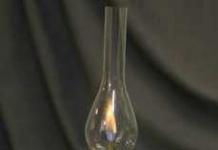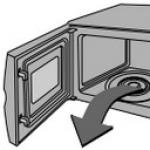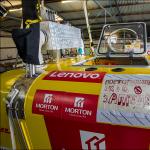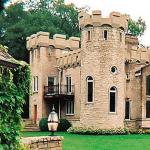Today, kerosene lamps are used only for decorative purposes, although once this simple and economical source of light conquered all of Europe and Russia in the blink of an eye and instantly replaced candles and oil lamps. The design of a kerosene lamp is simple - kerosene is poured into a metal container, into which the wick is immersed. The other end of the wick is used to light the lamp. As additional traction and protection from the wind, the wick is covered with a glass flask. In fact, a kerosene lamp is an improved model of an oil lamp, which has allowed many times to save money on lighting houses and streets.
The date of the invention of the kerosene lamp is considered to be 1853, but the first such lamps appeared in the East as early as the 9th century. The Baghdad poet Ar-Razi in his writings described a lamp that ran on oil and was lit with a cotton wick. Drawings of a similar device remained with us after Leonardo da Vinci. The great inventor added a glass cap to the metal container with fuel and the filter, which protected the fire from the wind.
However, the da Vinci lamp was never perfected. Its modern analogue was created in the laboratory of Lvov, and Jan Zech, a Hungarian by birth, had a hand in its invention.
The invention of the main lamp in the second half of the 19th century was preceded by a deal between Petr Mikolyash, an entrepreneur who owns the largest pharmacy in Lviv, and two cunning businessmen from Drohobych, who persuaded the pharmacist to buy distillate, allegedly to distill it into cheap alcohol. This building was given to Mikolyash's laboratory assistant, Jan Zech, who from now on spent days and nights experimenting with oil products. From toxic fumes, the unfortunate inventor even fainted, but his invention was worth such sacrifices. After purifying the distillate with concentrated sulfuric acid and soda, Jan Zech was the first in the world to obtain kerosene.
This is a good burning substance Yang decided to use as a substitute for fuel for oil lamps. He turned to the Lvov tinsmith Adam Bratkovsky, who redesigned an oil lamp for a kerosene one. In the spring of 1853, the first such lamp appeared in a pharmacy window, and on July 31 of the same year, a surgical operation was performed in one of the Lviv hospitals under the light of a kerosene lamp. This date is considered the starting point in the history of this light source.
Jan Zech, inspired by his success, quit his job in a pharmacy and opened his own shop that sold kerosene lamps. Already in 1854, his small company sold 60 tons of kerosene! Soon lamps from Zech began to be sold in Austria and Prussia. However, commercial success did not bring happiness to the inventor of the first kerosene lamp in his personal life. A few years later, a kerosene barrel exploded in his house, killing his wife and daughter.
After this tragic incident, Jan Zech decided to leave the kerosene business, moved to Borislav and opened the first pharmacy in the city there. There he lived until his death. However, Lvov did not forget his hero. On one of its streets there is a monument to a kerosene lamp and its inventor. The architectural composition depicts the pharmacist himself, sitting on a chair near an impressive kerosene lamp. On the back of a nearby chair, the author of the sculpture engraved the history of the creation of this light source.
But in Poland, they prefer not to remember Jan Zech, and the creation of a kerosene lamp is attributed to Ignatius Lukasevich. In fact, he was only an assistant to Zech, but the Poles prefer to consider their compatriot the creator of the first kerosene lamp. By the way, only the name of Jan Zech is listed in the patent book as the author of the original oil refining method.
After Jan Zech retired, mass production of kerosene lamps began in Vienna. Austrian lamps soon lit up the local train station and also began to be sold throughout Austria-Hungary. It is interesting that when kerosene lamps of Austrian origin appeared in Lviv, they were called Viennese, although Lviv was the birthplace of kerosene lighting. By the way, it is in the Lviv pharmacy-museum that the first copy of the kerosene lamp is stored.
March 1853. City of Lviv. It was here that the kerosene lamp was first demonstrated. On one of the clear spring evenings, passers-by noticed an unusual bright light that filled the premises of the Under the Golden Star pharmacy. Like moths flying into the light, people began to enter the pharmacy to look at the device that gave such a strong jet light.
The first kerosene lamp - the invention of the Polish pharmacist Ignatius Lukasiewicz - was a cylinder made of thick tin. The lower part of the device was reserved for a vessel with kerosene, and glass was placed in the upper part to cover the burning wick. The first lamp was quite large due to the metal plates surrounding the structure. Since the properties of kerosene were not fully understood, its use for indoor lighting caused many concerns.
Only after some time, having gained confidence in the reliability of the lamp design,  people began to massively replace candles and oil lamps with kerosene ones. The light produced by kerosene was much brighter than other lighting methods used before the invention of electricity. The very first "kerosene stoves" shone as brightly as several dozen wax candles. And with the improvement of designs, the addition of some additional details, the luminous intensity of the lamp could be compared with a 300-watt electric light bulb. But still, the main characteristic of any kerosene lamp was the size of the wick. It was on this that the power of light depended. Width was measured in lines - the old Russian and English measure of length. The size was usually stamped on the top of the lamp glass. It was this meaning that gave the popular nickname for the lamps, which were called "eight-line", "twenty-line", etc.
people began to massively replace candles and oil lamps with kerosene ones. The light produced by kerosene was much brighter than other lighting methods used before the invention of electricity. The very first "kerosene stoves" shone as brightly as several dozen wax candles. And with the improvement of designs, the addition of some additional details, the luminous intensity of the lamp could be compared with a 300-watt electric light bulb. But still, the main characteristic of any kerosene lamp was the size of the wick. It was on this that the power of light depended. Width was measured in lines - the old Russian and English measure of length. The size was usually stamped on the top of the lamp glass. It was this meaning that gave the popular nickname for the lamps, which were called "eight-line", "twenty-line", etc.
Two more important factors played a significant role in the rapid growth in the popularity of kerosene lamps: cost and beauty. In the second half of the 19th - early 20th century, oil production increased greatly. Therefore, kerosene, which is one of the by-products of oil refining, could be bought in many stores and pharmacies at relatively low prices.
As for beauty, due to strong competition and high demand, in just 40 years more than a thousand different models of kerosene lamps have been produced. Several large factories were engaged in their production at the end of the 19th century, the most famous of which was the Viennese factory "Brothers Brunner, Hugo Schneider and Rudolf Dietmar".
The metal parts of the lamp were made of bronze, less often of gilding and silver.  Individual specialists were engaged in the creation of new models and shapes of lamps: artists drew sketches, factories cast new forms and details, completed the process of creating a lamp by arranging all the details into a single structure. Additional decorations and some lamps on special orders were created at the best porcelain factories in Sevres (France) and Meissen (Germany).
Individual specialists were engaged in the creation of new models and shapes of lamps: artists drew sketches, factories cast new forms and details, completed the process of creating a lamp by arranging all the details into a single structure. Additional decorations and some lamps on special orders were created at the best porcelain factories in Sevres (France) and Meissen (Germany).
The demand for kerosene lamps by the masses of people in both cities and rural areas continued until the early 20th century. New light sources, powered by electric current, gradually replaced all other lighting devices. Of course, this did not happen in one year, and not even in ten years. Electrification was a long process that took many years. During the First World War, people continued to use kerosene lamps. Evidence of this can serve, for example, as the sisters of mercy were called - "carrying light in the dark." It was with a kerosene lamp in their hands that caring sisters went around patients in hospitals and infirmaries, looking for the wounded on the battlefields.
There were many things in the closet. Every time, before falling asleep, they told each other fairy tales they had invented themselves - these fairy tales were very similar to their own life.
Especially many good tales were told by an old chest and a porcelain piggy bank cat.
And the most stupid tales were told by an old teacup; the whole closet laughed at her tales, but she was not offended.
But once she told one really interesting tale.
A story about an old kerosene lamp.
2
Once upon a time there was a kerosene lamp. It was made a long time ago by a tinsmith, who bought lamp glass for it from a glass blower he knew, and went with it to the market.
I sold it at the market to an archivist I knew, and, having received the money, I bought everything at the same market of copper rivets, vinegar, bread, lamb, and went to the house ...
And the archivist brought the lamp home, filled it with kerosene, and lit it. The lamp worked great.
For many, many evenings, the archivist sat at the table with his archives and books, and that lamp stood on the table to his left.
And the lamp did not waste time: she quickly learned to read, and read books and archives together with the archivist ...
But the archivist died, the lamp was inherited by his children, then by the children of his children, and so on...
The lamp wandered from city to city, from house to house... From the closet to the table, from the table to the closet, from the closet to the shelf, from the shelf to the closet again...
The lamp has seen a lot. It was unlikely that her owners really needed her, but for some reason they didn’t throw her away, didn’t sell her, and probably completely forgot why they needed her ... So they took her with them from one house to another house, from city to city .
That lamp even survived the war.
3
And so, after many, many years, she ended up in one house, in a house where there was electric lighting, and she was put on a shelf only as an ornament - yes, she was beautiful. She knew about her beauty, but never arrogant.
Standing on the shelf, she tried to tell other things about her life, about what she saw. But things were much younger than her, and they never listened to her.
4
Once, when only a little son was left at home, and his parents had gone somewhere, he got to the shelf, removed the lamp from the shelf, poured kerosene into it, and lit it.
But as soon as he lit it, the lamp came to life. She felt like she was young again. She, in the furious burst of her flame, again decided to tell other things about herself.
But then the parents came. The little boy shuddered and dropped the lamp in surprise.
The glass broke, the lamp rolled against the wall, against the curtains, the curtains caught fire, beds and books caught fire...
Everything was on fire. And the lamp, our lamp, was now telling with all its might about its life, telling everything with more and more inspiration, talking incessantly, and no one could stop it until everything burned down ...
The use of lamps goes back centuries. Archaeological excavations have proven that oil lamps were used in ancient civilizations - in Babylon, Egypt, Greece and Rome. Lamp These lamps were made of ceramic or metal and consisted of a container with a combustion hole or tip, as well as an air supply hole and a wick. The ancients have long been convinced that a woven or twisted wick, due to its capillary properties, burns better than a directly combustible liquid. This discovery was the first step in a long process that led to the modern incandescent lamp. The oily liquid that was used in those ancient lamps, and also for many centuries, was extracted from animals or plants.
Accordingly, the light received from such lamps was very weak and inferior to candle fire, so candles were used as interior lighting for houses until the middle of the 19th century, when oil was discovered, which contributed to the further development of lamps. The role of candles in lighting at that time is evidenced by the fact that of the 81 supplier companies in London, two - Wax Chandlers and Tallow Chandlers - were candle makers, but none of the companies specialized in the production of candles. lamps. Of course, the purpose of this article is not at all to analyze the entire history of the existence of oil lamps. However, the author considers it necessary to pay attention to how their design gradually changed and new elements appeared, such as central thrust, ring wick, internal and external air supply, flame distributor, - all those innovations that ultimately led to the creation of a blue flame burner, to which a heating grid was later attached.
One of the first inventions that led to the incandescent lamp belongs to the Swiss Ami Argand (1755-1803), who lived in London and received a patent for his invention in 1784. His invention was to avoid unnecessary burning fuel, leading to the emission of smoke and soot. Argand proposed to direct one stream of air into the center of the flame, and the second - past the flame with the help of a lamp glass, cap, tip, funnel or tube, which would provide air draft. Unfortunately, there was no drawing in Argand's patent, but his idea formed the basis of a typical lamp named after him, which was later referred to by the authors of many publications. In the Argand lamp, the wick is a hollow cylinder that draws air both inside and outside the flame, resulting in more oxygen and therefore a brighter flame. Cylindrical lamp glass enhances air draft while helping to stabilize the flame and protecting it from external drafts.
After the industrial revolution of the late 18th century, the need for good lighting increased. Accordingly, at this time there is a noticeable improvement in the quality of the produced lamps. Between 1783 and 1836 the design of the lamp is changed, into which a flat woven wick and a round burner with a cylindrical wick and lamp glass are introduced; this design was named after its inventor - the Argand lamp. (Fig.1 and Fig.2). However, the lamp's improved design contrasted even more with the poor quality of animal and vegetable fuels, which produced little light. Of course, gas lighting was better, but it was used almost exclusively in large city houses, which forced the inventors to look for alternative lighting options. (Derry, Williams, Short History of Technology, Oxford University, 1960, p. 516./Short History of Technology, Derry & Williams, Oxford University, 1960, p. 516). IN  in the above book, the reference to the lamp of 1836 refers, apparently, to Houghton's lamp (Fig. 3). The design of this lamp contained an annular wick and was based on a circular supply of air coming from outside. The unusualness of this lamp lies in a spring mechanism that feeds liquid fuel up to the burner.In his design, Hughton used the Argand burner, which was widely used at that time.
in the above book, the reference to the lamp of 1836 refers, apparently, to Houghton's lamp (Fig. 3). The design of this lamp contained an annular wick and was based on a circular supply of air coming from outside. The unusualness of this lamp lies in a spring mechanism that feeds liquid fuel up to the burner.In his design, Hughton used the Argand burner, which was widely used at that time.
At that time, the inventors did not yet know how to provide sufficient air supply for complete combustion of the oil. The Bude light, invented by Gurney & Rixon in 1839, demonstrates one solution to this problem (Figure 4).
The Boudet burner, arranged according to the type of the Argand lamp, was called by its authors the Oxygen Mixture or the Bude Lamp. Its design was intended to burn flammable gas obtained by distillation from coal, oil, bituminous substances, etc. It was originally conceived as a signal lamp. In order to get a clean, bright light (using the fuel available at the time), a stream of oxygen was fed through a central tube into the interior of the flame, at the very top of the wick tube. The widespread use of oil lamps in the second half of the century became possible only due to the discovery of a method for separating light and heavy oil fractions, which was already known at that time in different countries. In 1848, in Derbyshire, James Young began work on refining oil, which was obtained from a source found in a coal deposit. In 1850, he patented a technology for refining oil at low temperatures. Markets soon emerged selling lamp oil, which Young called kerosene, while demonstrating to the public lamps suitable for burning it. According to Sir Edward Thorpe's Dictionary of Applied Chemistry, Vol. 5, 1924, kerosene soon became a source of light for the people of Britain.
Large quantities of oil began to be produced already in 1859 in Pennsylvania, and for many years the United States remained the main supplier of kerosene for lamps. Starting in the 1850s, kerosene lamps became widespread, as large areas in Europe and America were deprived of coal and gas lighting, and electricity appeared only at the end of the century.
 The great demand for lamps was a stimulus for the creation of new inventions, the purpose of which in the second half of the 19th century was to eliminate smell and smoke. Many early lamp designs used a flat wick, the top end of which passed through a hole into the cone of the burner. The burner was surrounded by lamp glass to allow air to enter and protect the flame from drafts. One of the typical samples of such a lamp was patented in 1877 in the USA by J.H. Boardman. The flat wick of this lamp was adjusted by a toothed gear. The upper end of the wick passed into the base of the burner, where the combustion air entered through the annular hole (Fig. 5).
The great demand for lamps was a stimulus for the creation of new inventions, the purpose of which in the second half of the 19th century was to eliminate smell and smoke. Many early lamp designs used a flat wick, the top end of which passed through a hole into the cone of the burner. The burner was surrounded by lamp glass to allow air to enter and protect the flame from drafts. One of the typical samples of such a lamp was patented in 1877 in the USA by J.H. Boardman. The flat wick of this lamp was adjusted by a toothed gear. The upper end of the wick passed into the base of the burner, where the combustion air entered through the annular hole (Fig. 5).
Boardman understood the danger associated with the use of this lamp, and therefore emphasized that the main component of his invention was a device for cutting off the supply of gas and heat. Gradually, this mechanism was improved by using an annular wick, which, as was subsequently proved, was an important element in the design of incandescent lamps. One of the examples of lamps of the late nineteenth century is the invention of Sepulchre (Sepulchre), created in 1893. In his lamp, the upper end of the annular wick is placed in a double cone. The cone served to distribute the air supply to the upper end of the wick and to the flame, which was cupped with a disk distributor.
 This study of the history of the development of incandescent lamps ends with a description of the so-called pressure lamps, the principle of which is based on the creation of increased pressure inside the fuel tank for its subsequent supply to the burner.
This study of the history of the development of incandescent lamps ends with a description of the so-called pressure lamps, the principle of which is based on the creation of increased pressure inside the fuel tank for its subsequent supply to the burner.
The lamps described above were used for domestic lighting and did not need increased pressure, since their design created sufficient air draft to the wick and incandescent grid.
However, portable lamps and lanterns for outdoor lighting needed to be protected from drafts and wind, so the burner, incandescent grid and the mechanism of connecting parts were placed inside a glass vessel or ball. As a result, in this design, the access of air was not sufficient to produce a blue flame, so it became necessary to change the internal structure of the lamp.
In rural areas, there has always been a need for widespread use of portable lamps. Previously existing lanterns, which used candles or burners with open oil supply, gave poor illumination. As the kerosene lamps used for indoor lighting improved, the inventors began to improve the design of the incandescent grid in portable kerosene lanterns.
The first version of the incandescent pressure lamp was produced in 1895 and consisted of a vertical incandescent grid and a mechanism for creating pressure in the fuel tank, which was necessary for the evaporation of liquid fuel (Fig. 16).
 In 1907, Aktibolaget Aladin from Sweden developed one of the first pressure lamps, which included a mechanism for the primary heating of the burner. In this design, the fuel supply pipe is located close to the heating grid, so the pipe heats up, and the fuel in it begins to evaporate. A similar mechanism was used in all later pressure lamp designs. Obviously, in this design, the evaporation of the fuel was not possible until the tube was heated, so a preheater was created. It consisted of a small round cuvette containing methyl alcohol or a similar liquid.
In 1907, Aktibolaget Aladin from Sweden developed one of the first pressure lamps, which included a mechanism for the primary heating of the burner. In this design, the fuel supply pipe is located close to the heating grid, so the pipe heats up, and the fuel in it begins to evaporate. A similar mechanism was used in all later pressure lamp designs. Obviously, in this design, the evaporation of the fuel was not possible until the tube was heated, so a preheater was created. It consisted of a small round cuvette containing methyl alcohol or a similar liquid.
Further improvement of the pressure lamp was associated with the use of two inverted incandescent grids in order to prevent the deposition of combustion products on the burner jet.
In 1930, a new pressure lamp design was proposed that used a different method of preheating the burner. An auxiliary burner was created that heated the evaporator before the main burner ignited and the inverted grate heated up (Fig. 17).
Later, another design was proposed, which included a curved evaporator. It was located around the burner and connected to the fuel supply pipe, which was located outside the lamp glass, inside which there was a burner and a heating grid.
The experience gained from the use of the pressure lamps described above has made it possible to successfully develop and use the described design.
A modern pressure lantern incorporates a pump in the fuel reservoir which pressurizes the air causing fuel to be pumped up the fuel tube. The fuel supply pipe passes through the inverted heating grid into the mixing chamber, into which air enters through 3 radial holes. From the mixing chamber, a mixture of air and fuel is supplied to the jet nozzle located inside the heating grid (Fig. 18).
For periodic cleaning of the nozzle hole from carbon deposits, a spike is provided in the design. At the base of the fuel supply tube there is a cuvette with alcohol and an asbestos cord. All this mechanism is enclosed in a glass vessel.
The incandescent lamp has not yet fallen into disuse. It is still used for indoor lighting in homes in areas of the UK where gas and electricity are not available. Using an incandescent lamp for decoration, such as table lighting, is much more effective than electric or gas lamps. In many countries, the incandescent lamp is still the best lighting device, and therefore its production will continue in the future.
In conclusion of this article, I want to thank the management of Aladdin Industries Ltd for providing access to the archives; company lawyer Mr. Robert H. Jacob of Chicago and Mr. W. S. Johnson, Jr. for a chronological review of the early development of incandescent lamps, and Mr. C. D. Eaglet for providing illustration material.
A. R. J. RAMSEY, C. P. A., (Member of Council)
Translation from English by Klevtsov A.M. ©
Kirill Sysoev
Calloused hands do not know boredom!
Mar 27 2018
For many years before the advent of electricity, kerosene lamps carried light to houses. There are many interesting pages in the history of this invention. To date, light sources based on the combustion of kerosene in the air have limited application. Modern models of such products are distinguished by their original design, which can decorate the interior of almost any room. You can buy a kerosene lamp today in a specialized online store with delivery by mail.
What is a kerosene lamp
This product is a lamp powered by the combustion of kerosene, which is a product of petroleum refining. The device of the lantern is relatively simple, due to which it was very popular in the 19th and early 20th centuries. After the widespread introduction of electric lighting, such products began to be used only in places where there is no electricity, and by tourists. Sometimes a kerosene lamp is used as an emergency light source. You need to use it like this:
- A lamp powered by kerosene emits the light of the greatest strength, provided that the wick is replaced at least 1 time in 2 months. The wick must fill the entire tube.
- The new wick is first dried and only then saturated with the oil product.
- Before lighting, the wick should be cleaned of soot and trimmed evenly with scissors.
- The height of the flame must be kept within 1-2.5 cm: a high height can lead to soot, and a low one can reduce the light intensity.
- Kerosene must be topped up regularly to prevent it from burning out completely.
Story
The first prototype of a kerosene lamp was an oil lamp, which was described by the poet Ar-Razi from Baghdad in the distant 9th century. The lamp of that time was a lamp made of a container of oil and a cotton wick floating in it. Such a source could give a weak light and at the same time smoke heavily. Changing the oil to a petroleum product increased brightness and reduced deposit formation. Due to the high volatility and fluidity of kerosene, the design of oil light sources has been noticeably simplified.
The first historical references to the use of kerosene for the operation of a lighting device date back to 1846. It is believed that Leonardo da Vinci also took part in the creation of kerosene lamps. He provided the sample with glass for the flow of air to the flame, but at the same time he tried to cool it with water - the glass could not stand it and simply burst.
The inventors of kerosene lamps (1853) are considered to be pharmacists from Lvov Jan Zekh and Ignaty Lukasevich, who improved the oil model and began to use an oil refining product for lighting. In the same 1853, Rudolf Dietmar from Vienna proposed his own design of a kerosene-powered device - he used a flat wick. The design became the prototype for the first mass-produced kerosene lamp, which began production in the United States three years later.
Another transformation was the so-called. "Auer grid". The light intensity of ordinary kerosene lamps reached several tens of candles, and the Auer grid increased the figure to 300 candles. This corresponds to the power of an incandescent lamp of 300 watts at a voltage of 110 volts. True, this did not help, because. the march of electricity was triumphant.

Device
A kerosene lamp is distinguished by a simple device and a principle of operation, which is approximately similar to an oil appliance. A combustible substance is poured into the container, from where it begins to be dosed into the combustion zone. The burner is sometimes equipped with means for removing combustion products and supplying air, and flame protection. The latter is an important element. To move and hang the lantern, the structure is provided with a frame. A lamp glass in the form of a tube of variable diameter is installed above the burner. Kerosene lamp device:
- fuel tank;
- tube with cap;
- bottom;
- wick tube;
- rack;
- shoulder for fixing the concentrating cone;
- bulb glass, which provides traction and protects the flame from the wind;
- insert, which is necessary in order to adjust the position of the wick in the cone hole in order to increase or decrease the flame.
Types of kerosene lamps
On sale in Moscow, St. Petersburg and other cities of the country, you can find several design options for kerosene lighting sources. The traditional type is wick products with an annular or flat wick, in which liquid fuel rises from the tank to the combustion zone due to the capillary effect. Cotton is used to make the wick. Previously, different types of wick structures were common: with protection against spillage of kerosene during capsizing, an air heating system to improve combustion, equipped with reflectors, wind-resistant, etc.
You can often find incandescent devices, which are close in design to a primus stove, i.e. wickless heating device. The fuel in them is under pressure, which is created by a manual pump. It rises to the combustion area through a tube, where it evaporates and heats up. Then from it kerosene vapors go to the burner, where the fuel burns out and heats the incandescent grid. Such types of lanterns burn much brighter due to the complete and rapid combustion of the refined product and the use of incandescent grids.
Traditionally, wicks and glasses for kerosene lamps are indicated in lines (a unit of distance). For example, the diameter of the lamp glass at the bottom of 20 lines is 50.8 mm. A device with a wick width of 7 lines (approximately 18 mm) became known as a seven-line. Kerosene light sources also differ from each other in their operating time and power. The first parameter, depending on the model, is from 4 to 20 hours, and the second - from 5 to 400 watts.
SPARTA
To make the best purchase of a kerosene lamp, pay attention to the shape of the bulb, dimensions, fuel tank volume and some other parameters. A popular option is the SPARTA Bat Light, which comes in a windproof design. The name comes from "Fledermaus" - that was the name of a German company that invented a wind-resistant lantern in the century before last. The bat kerosene lamp is designed for lighting outdoors and indoors. The outer surface of the case is painted with weatherproof enamel:
- model name: Bat SPARTA 932305;
- price: 319 rubles;
- characteristics: lampshade material - tin, glass bulb, protective coating of the body - galvanization, width at the base - 11.5 cm, height - 23.7 cm, weight - 337 g, brand homeland - Germany, country of origin - Germany, equipment - 2 wicks, 1 funnel, there is an adjustment of the brightness of the light, color - black or metallic;
- pluses: protective grill, heat-resistant glass bulb, stable stand;
- cons: flimsy mechanism, low quality.

FIT DIY
The FIT DIY 67600 kerosene luminaire is used to illuminate a small room in the event of a power outage. This model can also be used as a source of lighting in the country or in the garden. The tin body is equipped with a flask made of heat- and impact-resistant glass. The product has loops for hanging:
- model name: FIT DIY 67600;
- price: 473 rubles;
- characteristics: type - table lamp, country of manufacture - China, height - 24 cm, weight - 325 g, construction - metal;
- pluses: the presence of a protective grille, durable glass, a stable base;
- cons: flimsy case, more expensive than analogues.

PARK
Another great option is the PARK windproof luminaire, designed for lighting both indoors and outdoors. This model is ideal for a suburban area, to which electricity is not provided. The case is durable, on top there is an eyelet for hanging the structure. Lamp parameters:
- model name: PARK-235;
- price: 200 rubles;
- characteristics: height - 24.5 cm, tank capacity - 0.2 l, burning time at one gas station (approximate) - 14 hours, materials - glass, metal;
- pluses: convenient design, it is cheap;
- cons: no.
If you are looking for a lamp that burns longer than its counterparts, then pay attention to PARK-225. In appearance and design, this model does not differ from the previous one:
- model name: PARK-225;
- price: 280 rubles;
- characteristics: height - 28 cm, tank capacity - 0.3 l, burning time at one gas station (approximate) - 20 hours, materials - glass, metal;
- pluses: a good volume of capacity, burning time, convenient design, acceptable cost;
- cons: no.

How to choose a kerosene lamp
When buying a lamp that runs on kerosene, please note that such a light source will not be able to illuminate large rooms. It is ideal for small rooms (for example, in a country house) and for tourist use. Main selection criteria:
- Pay attention to the case, which must be strong and durable. It is often made of tin, which can leave traces of dents, but its use reduces the weight of the lantern and the cost. True, durable material can significantly increase the cost of production, but in return you get a reliable and durable lantern that runs on kerosene fuel.
- Make sure that the base of the light fixture is really stable, otherwise it may tip over in any light breeze - the fuel will spread out, which can be dangerous.
- If possible, find out the volume of the fuel tank, because the more it holds, the longer the kerosene lamp will illuminate the room with light.
- The bulb glass must be impact and heat resistant to protect users from direct contact with the flame.
- It is good if the lamp is equipped with suspension loops, a protective grille and the ability to adjust the brightness.
Video


















